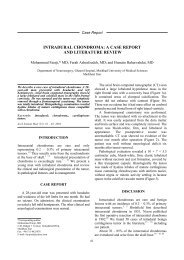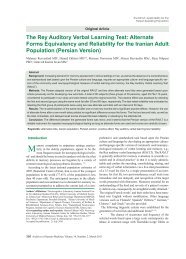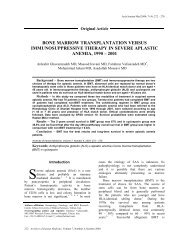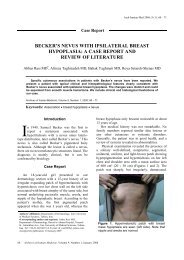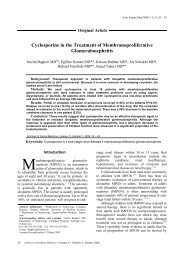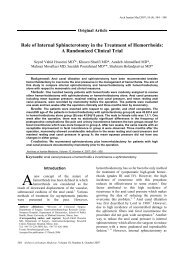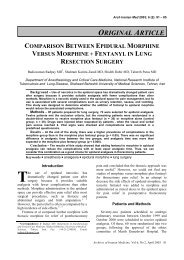SUCCESSFUL TREATMENT OF VITILIGO WITH PUNCH GRAFT ...
SUCCESSFUL TREATMENT OF VITILIGO WITH PUNCH GRAFT ...
SUCCESSFUL TREATMENT OF VITILIGO WITH PUNCH GRAFT ...
- No tags were found...
Create successful ePaper yourself
Turn your PDF publications into a flip-book with our unique Google optimized e-Paper software.
AZ. Hallaji, M. Daneshpazhooh, S. Rezai-KhiabanlooBABFigure 2. Photograph of patient No. 1 showing a vitiligo lesion on the trunk (75 cm 2 ): A) beforegrafting; and B) 7 months after grafting, showing 90% repigmentation.of PUVA, while four patients (3 generalized, and 1localized) showed no repigmentation despite theaddition of PUVA.Fitzpatrick skin type IV patients respondedbetter than other types. Also, the response rate washigher on the trunk, followed by the face andextremities. Segmental vitiligo responded betterthan focal type. The least responsive group was thegeneralized type. Complete response to PUVA infour nonresponders to minigrafting and partialresponse in three nonresponders was an interestingfinding in our study. This can be explained by theeffect of methoxypsoralen plus UVA on thedonor’s melanocytes.Kobner phenomenon was seen in two patientsafter minigrafting at recipient sites and in anotherone at the donor site. Cobblestoning was seen in55% of patients. Repigmentation was nearlyuniform.After 1 year of follow-up, no hyperpigmentationwas seen and only cosmetically acceptablemild cobblestoning was noted in 7 patients andresolved in others. Other possible side effects suchas infection, hypertrophic scarring, keloids,persistent pigmentary changes and necrosis of thegrafts were not seen. The combination of punchgrafting and topical PUVA was an effectivetreatment in a small group of stable and intractablevitiligo, especially segmental and localized types.We suggest further studies to evaluate whetherearlier institution of PUVA after minigrafting leadsto an earlier satisfactory response. Also, wesuggest comparing this method with othertechniques such as Thiersch grafting andsuctioning blister epidermis in combination withPUVA or narrow-band UVB phototherapy infurther studies.References1 Grimes PE. Therapies for vitiligo. In: Millikan LE,ed. Drug Therapy in Dermatology. 1st ed. New York:Marcel Dekker; 2000: 339 – 57.2 Boersma BR, Westerhof W, Bos JD. Repigmentationin vitiligo vulgaris by autologous minigrafting: resultsin nineteen patients. J Am Acad Dermatol. 1995; 33:990 – 5.3 Falabella R. Surgical techniques for repigmentation.In: Robinson JK, Arndt KA, LeBoit PE, et al, eds.Atlas of Cutaneous Surgery. 1st ed. Philadelphia: WBSaunders; 1996: 175 – 84.4 Suga Y, Butt KI, Takimoto R , et al. Successfultreatment of vitiligo with PUVA-pigmentedautologous epidermal grafting. Int J Dermatol. 1996;35: 518 – 22.5 Ai-Young L, Jeong-Hoon J. Autologous epidermalgrafting with PUVA-irradiated donor skin for thetreatment of vitiligo. Int J Dermatol. 1998; 37:551 – 4.6 Westerhof W, Nieuweboer-Krobotova L, Mulder PG,et al. Left-right comparison study of the combinationof fluticasone propionate and UV-A vs eitherfluticasone propionate or UV-A alone for the longtermtreatment of vitiligo. Arch Dermatol. 1999; 135:1061 – 6.7 Falabella R. Repigmentation of segmental vitiligo byautologous minigrafting. J Am Acad Dermatol. 1983;9: 514 – 21.8 Falabella R. Treatment of localized vitiligo byautologous minigrafting. Arch Dermatol. 1988; 124:1649 – 55.9 Gauthier Y, Surleve-Bazeilla JE. Autologous graftingwith noncultured melanocytes: a simplified methodfor treatment of depigmented lesions. J Am AcadArchives of Iranian Medicine, Vol 6, No 2, April 2003 89



